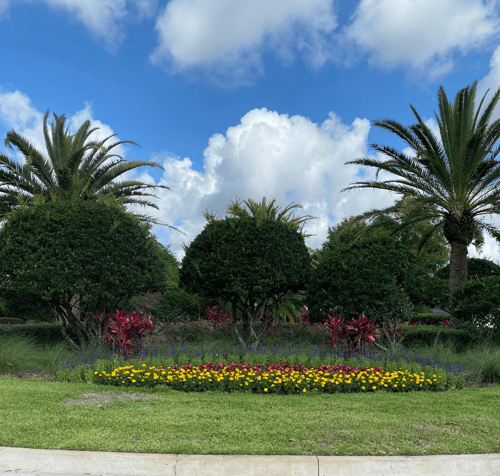
Home / Here on Earth / Tips for the Perfect Florida Landscape
With the extreme Florida heat and sandy soil, landscaping can be difficult for Sunshine State residents. Here are some primary concepts to build a sustainable, attractive outdoor environment to keep in mind when deciding to freshen up your landscape.
Florida’s Unique Landscape
Landscaping dreams are made with healthy soil. Moisture, nutrients, and bacteria can all be held in this loose material. In Florida, the soil composition is a bit different, causing much of the important nutrients to frequently wash through the thin sand commonly found in soil.
.jpg?width=500&height=375&name=bb-compressed%20(1).jpg)
The sandy soil of Florida may use a nutrient boost. The quickest way to accomplish this is through compost, which you can prepare yourself. Consider it natural recycling. Compost kitchen wastes such as banana peels, wilting lettuce, and yard debris instead of throwing them away.
Always Use Native Plants
Plants that are native to Florida should be used. The plants will not only easily to adapt to Florida's climate and sandy soil types, but it also requires minimal maintenance. This means less weeding, watering, and fertilization.
Native plants include ferns, wildflowers, grass, ground cover, palm trees, vines, trees shrubs, and colorful flowers which are known to attract butterflies and birds with their colors. When looking at native plants, keep in mind Florida is a large state that has multiple regions in terms of climate. Depending on which Floridian region the landscape resides in, this can differ which plants are native and could thrive in the climate, naturally.
Beware of Rain and Storms
The rainy season in Florida runs from June 1st until September 30th. Thunderstorms and even hurricanes are likely to be a part of your daily routine throughout this season. Even afternoon storms can bring strong winds and heavy rain. As a result, your landscape must be prepared as well.
Heavy rains can damage young plants, wash away root coverings, and erode the soil around the roots of the plants. Damaged or dead parts of the plant should be pruned immediately after the storm so that the plant can recover.
Following are the steps you can go with to prepare your landscape from storm:
1. Use stakes to secure young trees and plants.
2. Remove dead branches and hanging fruit that become projectiles in high winds during storm season.
3. Make sure your drainage system and gutters are in good working order and free of obstructions.
Plant for the Wildlife
When you landscape with wildlife insight, you're contributing to a balanced and healthy ecosystem.
What's the reward?
The insect-eating birds, bees, and dragonflies that fly will benefit your plants. This helps in the prevention of pest damage to plants. Furthermore, many of these insects help in pollination, allowing the plants to reproduce.
A diversified combination of vines, flowers, ground coverings, shrubs, trees, and palms should be your goal. Why? because plants supply wildlife with food (think nectar, seeds, or berries), water, and shelter. Milkweed, for example, attracts butterflies, and the American beautyberry shrub produces clusters of purple berries that cardinals and sparrows love.
Efficient Use of Water
Florida has a dry season from November to April and a wet season from May to October, with blistering summer temperatures. Top off gardens with a thick layer of mulch to maintain soil moisture resulting from rainfall and irrigation. This also helps to keep weeds at bay. Consider replacing hard surfaces, such as concrete walkways, with porous materials, such as brick or gravel, to allow rainwater to flow into the soil.
Landscaping with Down To Earth
Although Florida has its own set of rules for getting the most out of your landscape game, that doesn't mean there isn't still a lot of fun to be had. If you follow the guidelines, you'll be impressed with the landscape you design.
It's easier to learn than it is to practice Florida's landscaping. These tips are guidelines, meant to be used along with regular professional maintenance services. Down To Earth Landscape & Irrigation professionals are aware of Florida’s climate and landscaping. Contact us today for a free estimate!

